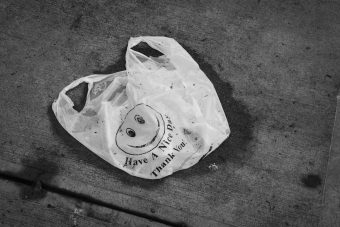
A novelty in the 1970s, plastic shopping bags are now an omnipresent product found in every corner of the world. Produced at a rate of up to one trillion bags per year, they are showing up in the darkest depths of the ocean to the summit of Mount Everest to the polar ice caps. Being so widespread, plastic bags are intensifying some major environmental challenges.
So where did they come from and how did we reach this point?
1933 – Polyethylene, the most commonly used plastic, is created by accident at a chemical plant in Northwich, England. While polyethene had been created in small batches before, this was the first synthesis of the material that was industrially practical. Seeing its potential, it was initially used in secret by the British military during World War II.
1965 – The one-piece polyethylene shopping bag is patented by the Swedish company Celloplast. Designed by engineer Sten Gustaf Thulin, the plastic bag quickly begin to replace cloth and plastic in Europe.
1982 – Safeway and Kroger, two of the biggest supermarket chains in the United States, switch to plastic bags. Though they are yet to be fully accepted by shoppers, single-use plastic bags are cheaper than alternatives, and more stores begin to follow Safeway and Kroger’s switch. By the end of the decade, plastic bags will have almost entirely replaced paper bags around the world.
1997 – Sailor and researcher Charles Moore discovers the Great Pacific Garbage Patch, the largest of several gyres in the world’s oceans where immense amounts of plastic waste have accumulated. Threatening marine life, this immense collection of marine litter and plastic pollution showcases the long-lasting and harmful effects of single-use plastic products.
2002 – Bangladesh is the first country in the world to implement a ban on thin plastic bags, after it was found they played a key role in clogging drainage systems during disastrous flooding. Other countries begin to follow suit.
More:
2011 – Worldwide, one million plastic bags are consumed every minute.

2018 – As of July 2018, the United Nations Environment Programme (UNEP) finds that 127 out of 192 countries reviewed have enacted some form of national legislation to address the problem of plastic bags.
2018 – #BeatPlasticPollution is chosen as the theme of World Environment Day, hosted by India. Companies and governments around the world continue to announce new pledges to tackle plastic waste.
2019 – The European Union’s (EU) Directive on single-use plastics takes effect as the EU aims to lead the fight against marine litter and plastic pollution.
2020 – Recognizing its massive waste problem, China commits to strengthening national plastic pollution control, ushering in an era of single-use plastic reduction.
2022 – A major milestone turning the tide on plastic, the United States agrees to support a global treaty to combat ocean plastic pollution, setting the stage for international cooperation and action.
Source: UNEP





